key MERCEDES-BENZ C-Class 2000 W202 User Guide
[x] Cancel search | Manufacturer: MERCEDES-BENZ, Model Year: 2000, Model line: C-Class, Model: MERCEDES-BENZ C-Class 2000 W202Pages: 130, PDF Size: 2.43 MB
Page 22 of 130
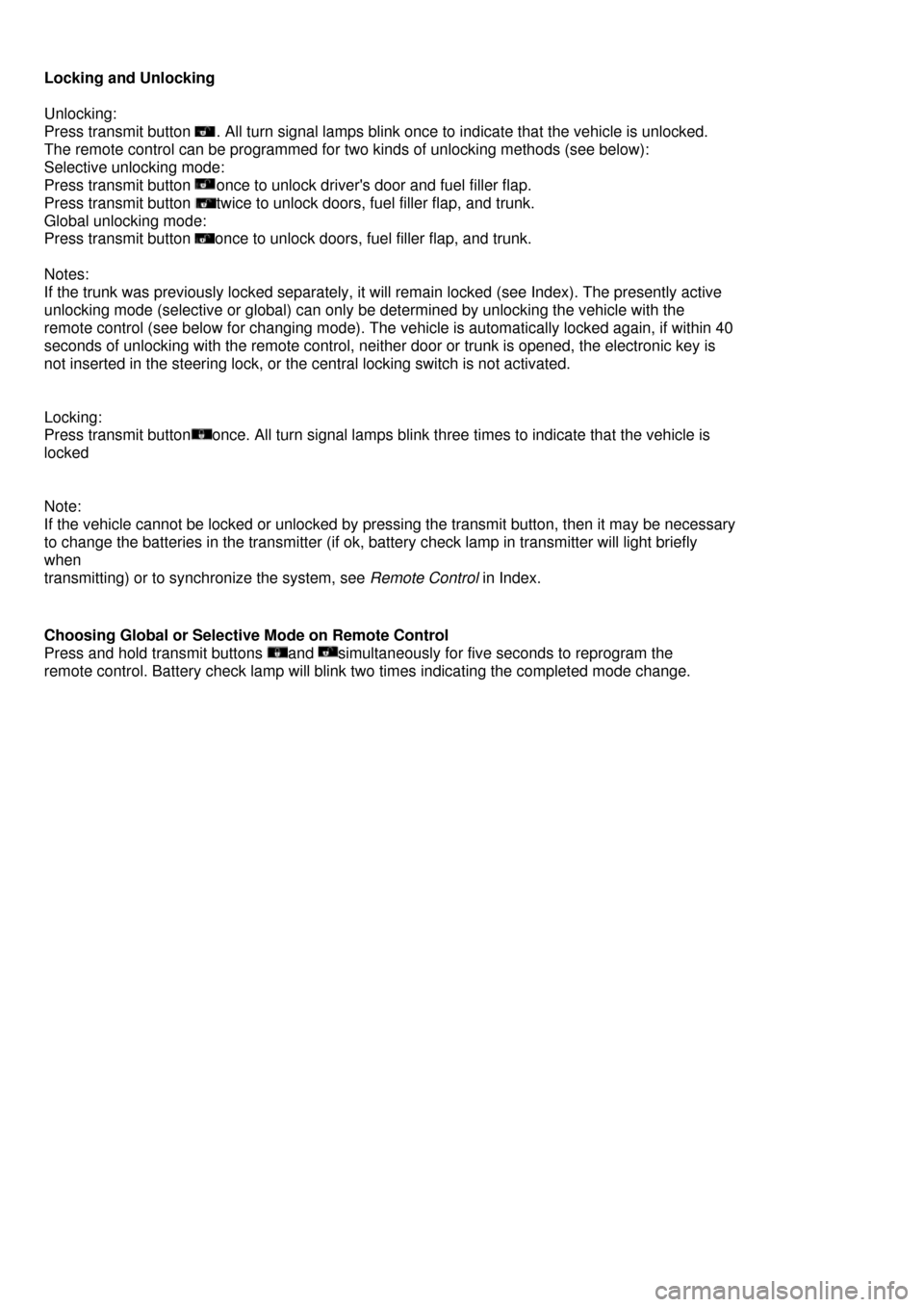
Locking and Unlocking
Unlocking:
Press transmit button . All turn signal lamps blink once to indicate that the vehicle is unlocked.
The remote control can be programmed for two kinds of unlocking methods (see below):
Selective unlocking mode:
Press transmit button once to unlock driver's door and fuel filler flap.
Press transmit button twice to unlock doors, fuel filler flap, and trunk.
Global unlocking mode:
Press transmit button once to unlock doors, fuel filler flap, and trunk.
Notes:
If the trunk was previously locked separately, it will remain locked (see Index). The presently active
unlocking mode (selective or global) can only be determined by unlocking the vehicle with the
remote control (see below for changing mode). The vehicle is automatically locked again, if within 40
seconds of unlocking with the remote control, neither door or trunk is opened, the electronic key is
not inserted in the steering lock, or the central locking switch is not activated.
Locking:
Press transmit buttononce. All turn signal lamps blink three times to indicate that the vehicle is
locked
Note:
If the vehicle cannot be locked or unlocked by pressing the transmit button, then it may be necessary
to change the batteries in the transmitter (if ok, battery check lamp in transmitter will light briefly
when
transmitting) or to synchronize the system, see Remote Control in Index.
Choosing Global or Selective Mode on Remote Control
Press and hold transmit buttons and simultaneously for five seconds to reprogram the
remote control. Battery check lamp will blink two times indicating the completed mode change.
Page 23 of 130

Opening the Trunk
A minimum height clearance of 5.9 ft ( 1.8 m) is required to open the trunk lid.
Press transmit button until trunk lid is open.
Important !
Do not place remote control in trunk since trunk is locked again when closing the lid.
Note:
If the trunk was previously locked separately, it will remain locked (see Index).
Opening and Closing Windows and Sliding/Pop-Up Roof from Outside
Aim transmitter eye (5) of remote control at door receivers (6 or 7).
To open:
Continue to press transmit button after unlocking car
The windows and sliding/pop-up roof begin to open after approx. 1 second. To interrupt opening
procedure, release button.
To close:
Continue to press transmit button after locking car
The windows and sliding/pop-up roof begin to close after approx. 1 second. To interrupt closing
procedure, release button.
Warning !
Never operate the windows or sliding/pop-up roof if there is the possibility of anyone being
harmed by the opening or closing procedure.
In case the procedure causes potential danger, the procedure can be immediately halted by
releasing the remote control button. To reverse direction of movement press for opening
or for closing.
Note:
If the windows and sliding/ pop-up roof cannot be operated automatically by pressing the transmit
button of the remote control then it may be necessary to change the batteries in the transmitter
(if ok, battery check lamp in transmitter will light briefly when transmitting), or to synchronize the
electronic main key, see Synchronizing remote Control in Index.
Page 24 of 130
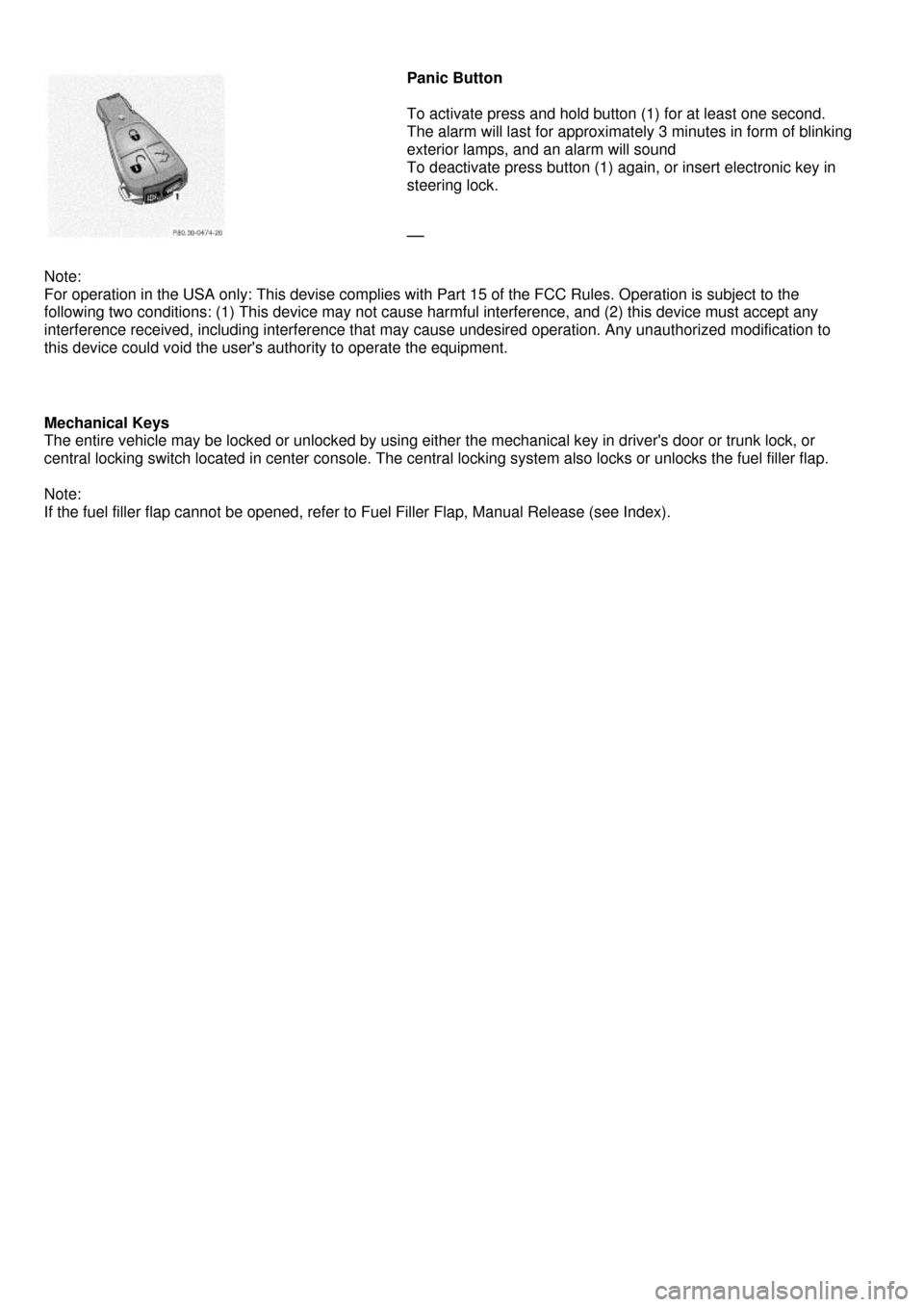
Panic Button
To activate press and hold button (1) for at least one second.
The alarm will last for approximately 3 minutes in form of blinking
exterior lamps, and an alarm will sound
To deactivate press button (1) again, or insert electronic key in
steering lock.
Note:
For operation in the USA only: This devise complies with Part 15 of the FCC Rules. Operation is subject to the
following two conditions: (1) This device may not cause harmful interference, and (2) this device must accept any
interference received, including interference that may cause undesired operation. Any unauthorized modification to
this device could void the user's authority to operate the equipment.
Mechanical Keys
The entire vehicle may be locked or unlocked by using either the mechanical key in driver's door or trunk lock, or
central locking switch located in center console. The central locking system also locks or unlocks the fuel filler flap.
Note:
If the fuel filler flap cannot be opened, refer to Fuel Filler Flap, Manual Release (see Index).
Page 25 of 130

Doors
1. Opening - pull handle
2. Unlocking
3. Locking
4. Individual door from inside:
• Push lock button down to lock.
• Pull lock button up to unlock.
When you lock the car, all door lock buttons should move down. If any one stays up, the respective
door is not properly closed. You should then unlock the car, open and reclose this door, and lock the
vehicle again.
Each individual door can be locked with door lock button - the driver's door can only be locked when
it is closed. If the car has previously been locked from the outside, only the door being opened from
the inside will unlock, and the alarm will corne on. The remaining doors, the trunk lid and fuel filler
flap remain locked.
Notes:
In case of a malfunction in the central locking system the doors can be locked and unlocked
individually. To lock, turn mechanical key to position 3 or push down lock buttons. To unlock, turn
mechanical key to position 2 or pull up lock buttons.
Page 26 of 130

Central locking switch
1. Locking
2. Unlocking
The central locking switch is located in the center console. The doors can only be locked with the central locking
switch, if the front doors are closed. If the car was previously locked with the remote control or mechanical key, the
doors and trunk cannot be unlocked with the central locking switch. If the vehicle was previously locked with the
central locking switch, while in the selective remote control mode, only the door opened from the inside is unlocked. If
the vehicle was previously locked with the central locking switch, while in the global remote control mode, the
complete vehicle is unlocked when a front door is opened from the inside.
Note
The fuel filter flap cannot be locked or unlocked with the central locking switch.
Automatic Central Locking
The central locking switch also operates the automatic central locking.
To activate:
With electronic key in steering lock position 2 hold upper portion of switch (1) for a minimum of 5 seconds.
To deactivate:
With electronic key in steering lock position 2 hold lower portion of switch (2) for a minimum of 5 seconds.
With the automatic central locking system activated, the doors and trunk are locked at vehicle speeds of approx. 9
mph (15 km/h) or more. The fuel filler flap remains unlocked.
Notes:
If doors are unlocked with the central locking switch after activating the automatic central locking, and neither door is
opened, then the doors remain unlocked even at vehicle speeds of approx. 9 mph (15 km/h) or more. Opening a door
from the inside at speeds of approx. 9 mph (15 km/h) or less with the automatic central locking activated, the door will
again be automatically locked at speeds of approx. 9 mph (15 km/h) or more.
Important
When towing the vehicle, or with the vehicle on a dynamometer test stand, please, note the following:
With the automatic central locking activated and the electronic key in steering lock position 2, the vehicle doors
lock if the left front wheel as well as right rear wheel are turning at vehicle speeds of approx. 9 mph (15 km/h) or
more. to prevent the vehicle door locks from locking, deactivate the automatic central locking.
Emergency Unlocking in Case of Accident
The doors unlock automatically a short time after an accident (this is intended to aid rescue and exit).
However, the electronic key must still be in the steering lock.
Page 27 of 130
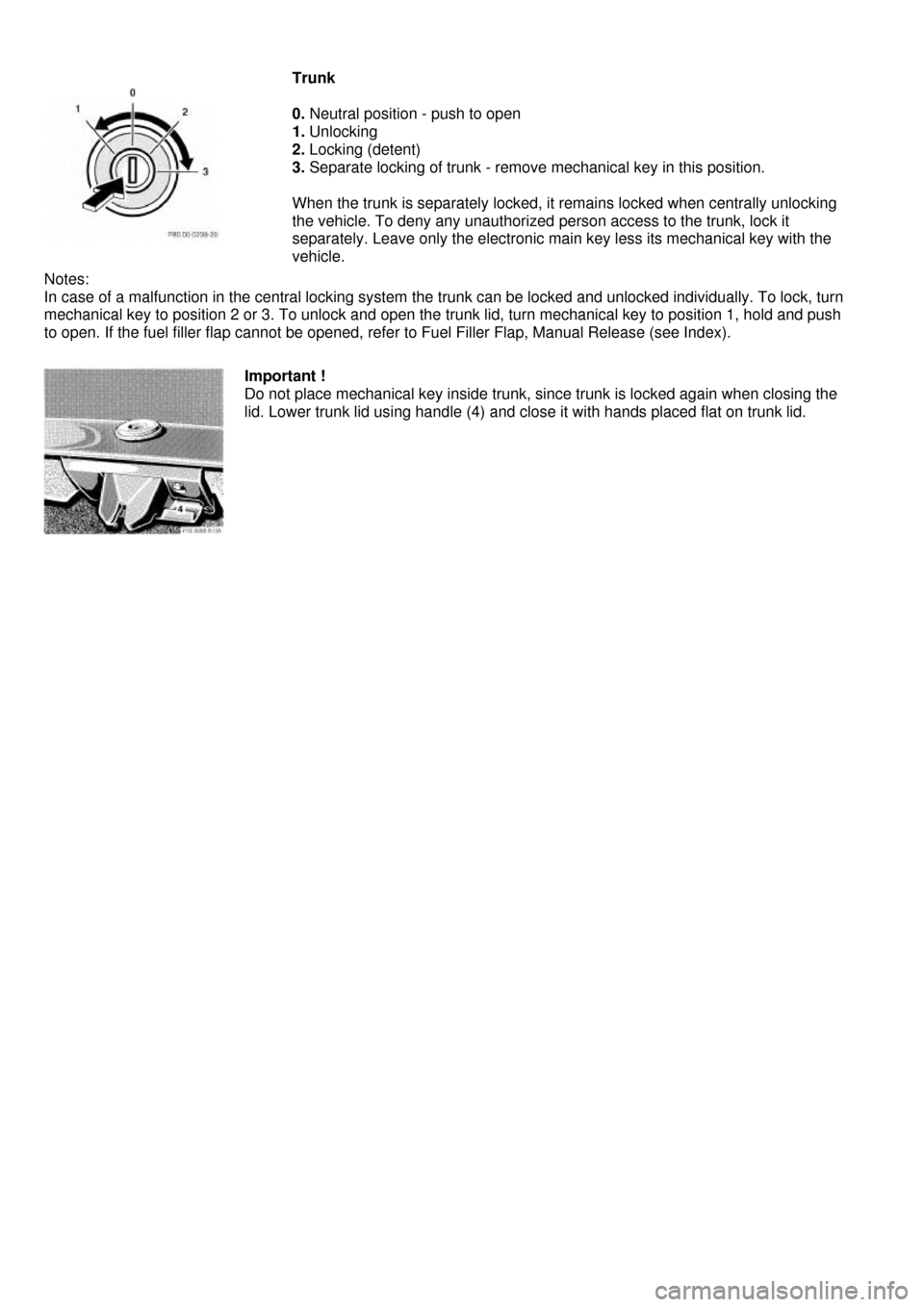
Trunk
0. Neutral position - push to open
1. Unlocking
2. Locking (detent)
3. Separate locking of trunk - remove mechanical key in this position.
When the trunk is separately locked, it remains locked when centrally unlocking
the vehicle. To deny any unauthorized person access to the trunk, lock it
separately. Leave only the electronic main key less its mechanical key with the
vehicle.
Notes:
In case of a malfunction in the central locking system the trunk can be locked and unlocked individually. To lock, turn
mechanical key to position 2 or 3. To unlock and open the trunk lid, turn mechanical key to position 1, hold and push
to open. If the fuel filler flap cannot be opened, refer to Fuel Filler Flap, Manual Release (see Index).
Important !
Do not place mechanical key inside trunk, since trunk is locked again when closing the
lid. Lower trunk lid using handle (4) and close it with hands placed flat on trunk lid.
Page 28 of 130

Power Windows and Sliding/Pop-Up Roof
1. Opening
2. Interrupting
3. Closing
When locking doors or trunk, turn mechanical key in door lock or trunk lock to position 3 and hold.
The windows and the sliding/pop-up roof begin to close automatically after approximately 1 second.
To interrupt the closing procedure, turn mechanical key to position 2. When unlocking doors or trunk,
turn mechanical key in door lock or trunk lock to position 1 and hold. The windows and the
sliding/pop-up roof begin to open automatically after approximately 1 second. To interrupt the opening
procedure, turn mechanical key to position 2.
Warning !
Never operate the windows or sliding/pop-up roof if there is the possibility of anyone being
harmed by the procedure. In case the procedure causes potential danger, the procedure can
be immediately reversed by turning the mechanical key to the reversed operational direction:
• for opening position (1)
• for closing position (3).
Note:
If the opening/closing procedure is interrupted, it can only be continued by first turning the mechanical
key to the interrupting position (2) and then again to the opening/ closing position (1 or 3) and hold.
Page 29 of 130
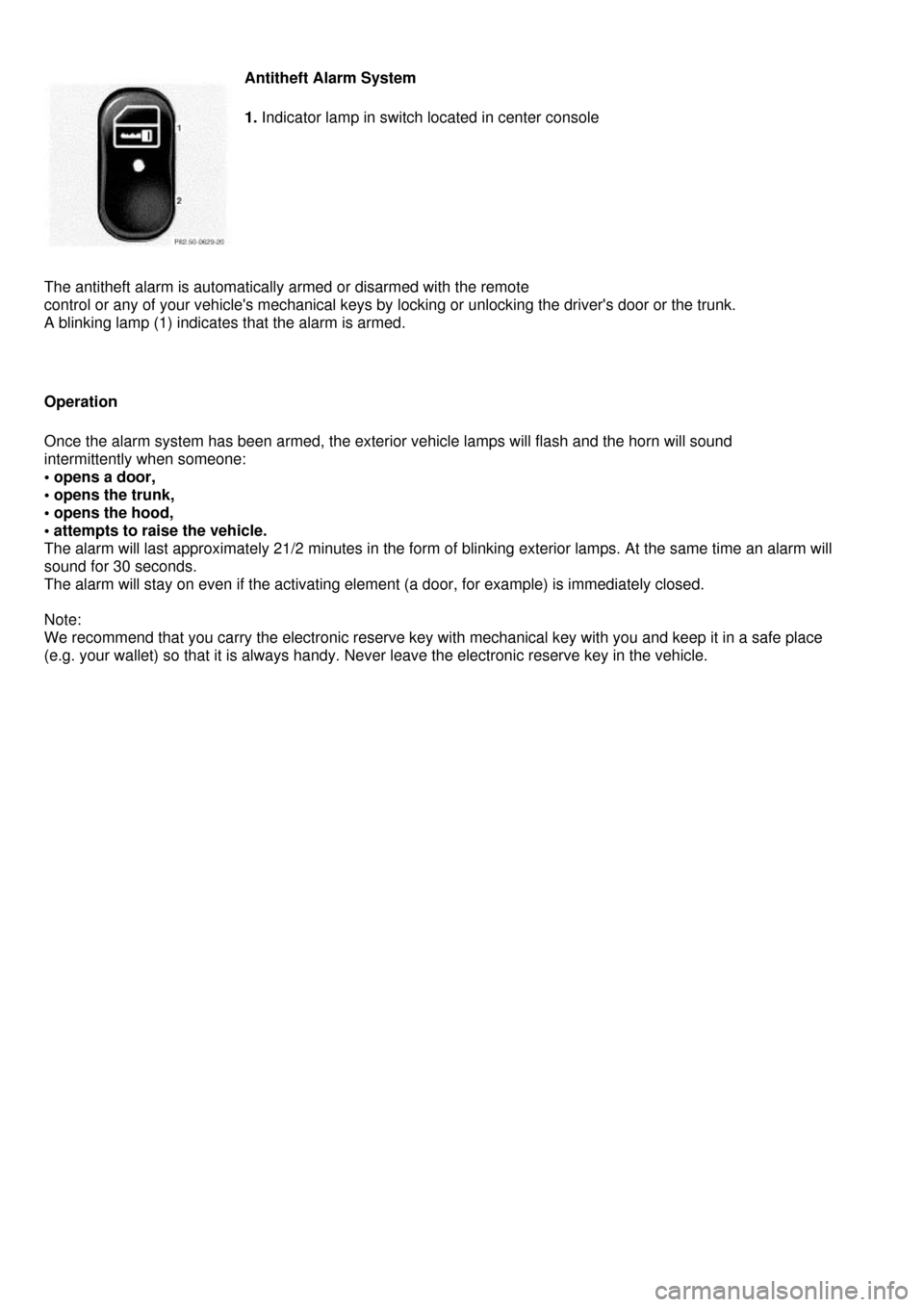
Antitheft Alarm System
1. Indicator lamp in switch located in center console
The antitheft alarm is automatically armed or disarmed with the remote
control or any of your vehicle's mechanical keys by locking or unlocking the driver's door or the trunk.
A blinking lamp (1) indicates that the alarm is armed.
Operation
Once the alarm system has been armed, the exterior vehicle lamps will flash and the horn will sound
intermittently when someone:
• opens a door,
• opens the trunk,
• opens the hood,
• attempts to raise the vehicle.
The alarm will last approximately 21/2 minutes in the form of blinking exterior lamps. At the same time an alarm will
sound for 30 seconds.
The alarm will stay on even if the activating element (a door, for example) is immediately closed.
Note:
We recommend that you carry the electronic reserve key with mechanical key with you and keep it in a safe place
(e.g. your wallet) so that it is always handy. Never leave the electronic reserve key in the vehicle.
Page 30 of 130
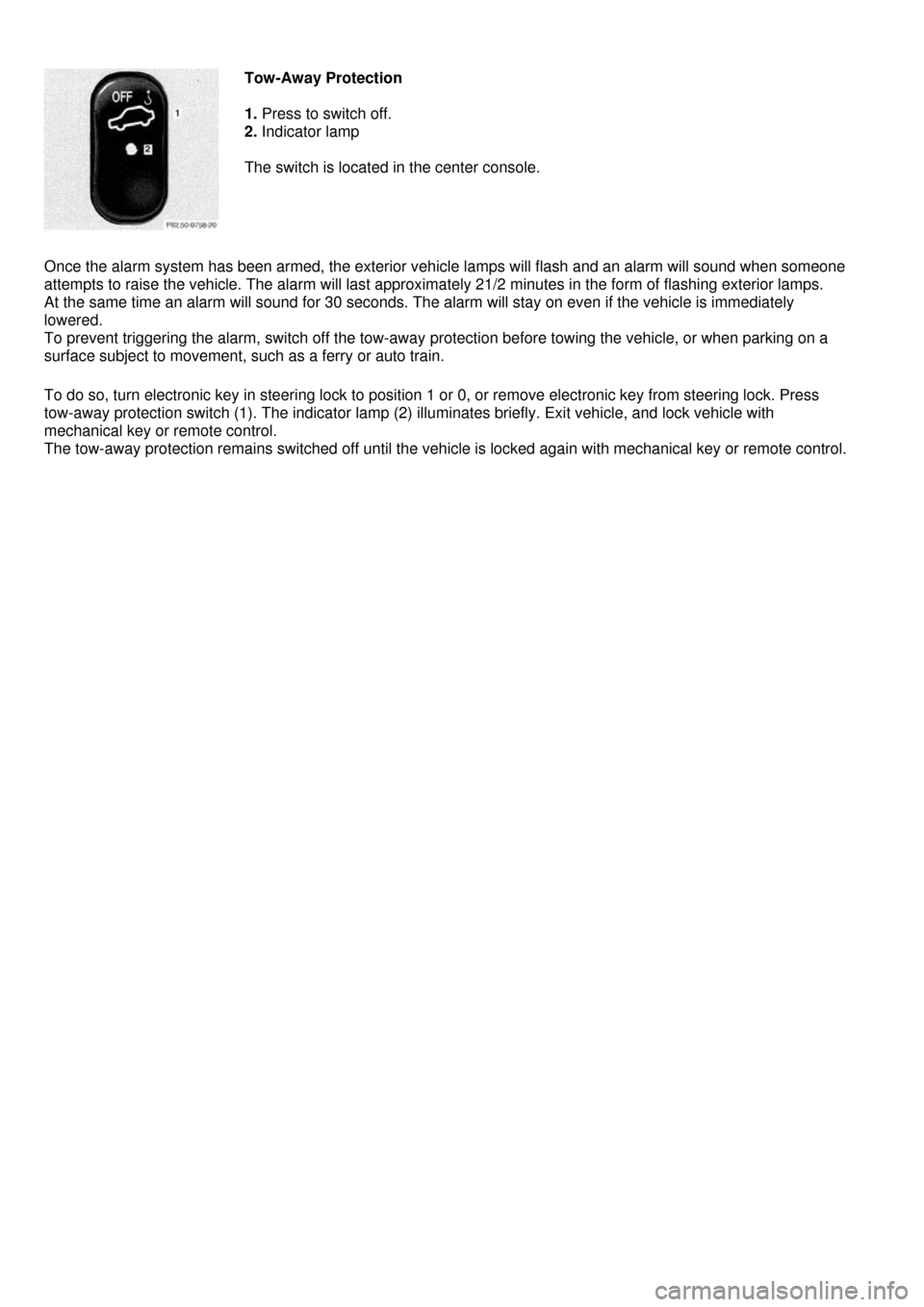
Tow-Away Protection
1. Press to switch off.
2. Indicator lamp
The switch is located in the center console.
Once the alarm system has been armed, the exterior vehicle lamps will flash and an alarm will sound when someone
attempts to raise the vehicle. The alarm will last approximately 21/2 minutes in the form of flashing exterior lamps.
At the same time an alarm will sound for 30 seconds. The alarm will stay on even if the vehicle is immediately
lowered.
To prevent triggering the alarm, switch off the tow-away protection before towing the vehicle, or when parking on a
surface subject to movement, such as a ferry or auto train.
To do so, turn electronic key in steering lock to position 1 or 0, or remove electronic key from steering lock. Press
tow-away protection switch (1). The indicator lamp (2) illuminates briefly. Exit vehicle, and lock vehicle with
mechanical key or remote control.
The tow-away protection remains switched off until the vehicle is locked again with mechanical key or remote control.
Page 31 of 130
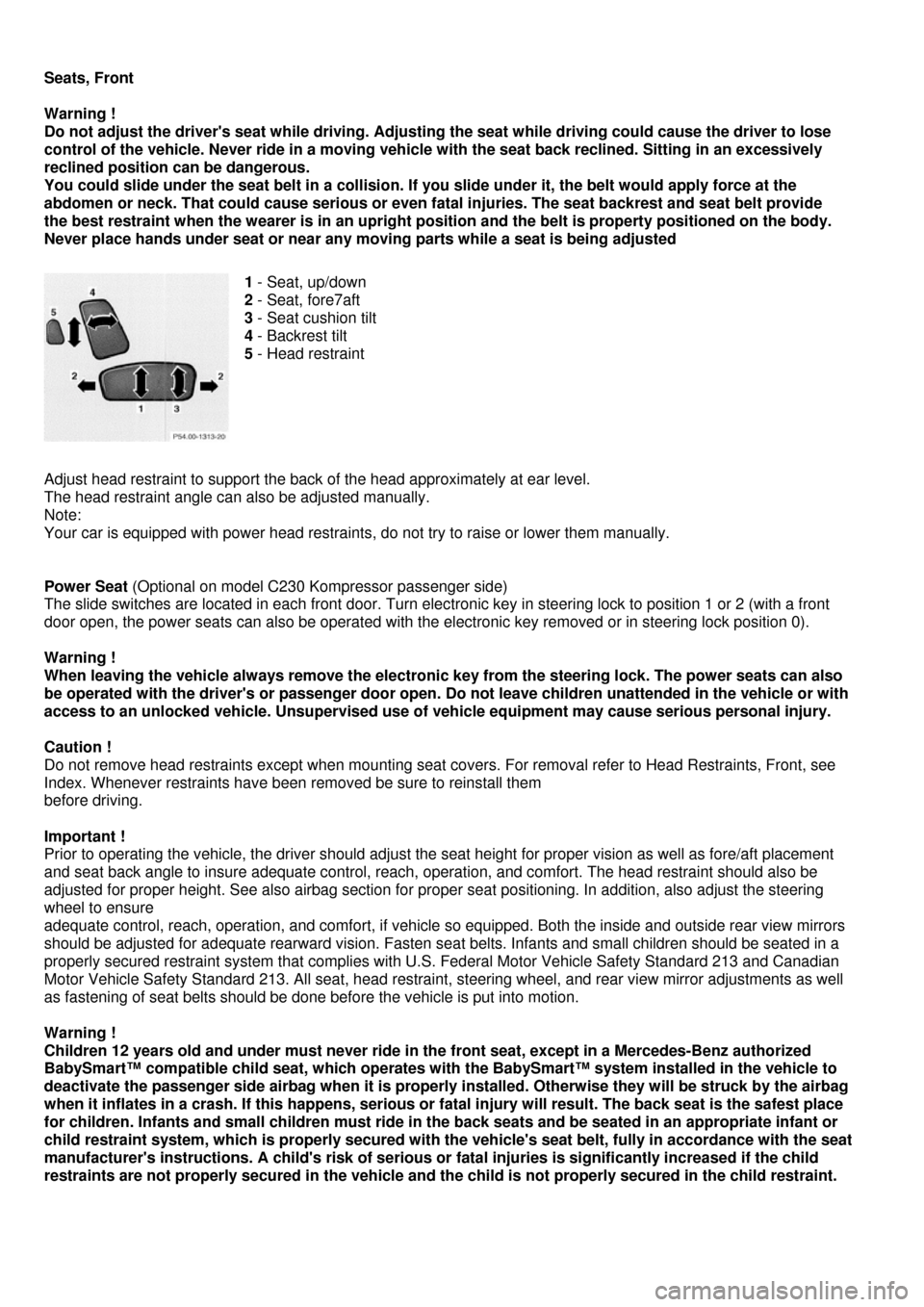
Seats, Front
Warning !
Do not adjust the driver's seat while driving. Adjusting the seat while driving could cause the driver to lose
control of the vehicle. Never ride in a moving vehicle with the seat back reclined. Sitting in an excessively
reclined position can be dangerous.
You could slide under the seat belt in a collision. If you slide under it, the belt would apply force at the
abdomen or neck. That could cause serious or even fatal injuries. The seat backrest and seat belt provide
the best restraint when the wearer is in an upright position and the belt is property positioned on the body.
Never place hands under seat or near any moving parts while a seat is being adjusted
1 - Seat, up/down
2 - Seat, fore7aft
3 - Seat cushion tilt
4 - Backrest tilt
5 - Head restraint
Adjust head restraint to support the back of the head approximately at ear level.
The head restraint angle can also be adjusted manually.
Note:
Your car is equipped with power head restraints, do not try to raise or lower them manually.
Power Seat (Optional on model C230 Kompressor passenger side)
The slide switches are located in each front door. Turn electronic key in steering lock to position 1 or 2 (with a front
door open, the power seats can also be operated with the electronic key removed or in steering lock position 0).
Warning !
When leaving the vehicle always remove the electronic key from the steering lock. The power seats can also
be operated with the driver's or passenger door open. Do not leave children unattended in the vehicle or with
access to an unlocked vehicle. Unsupervised use of vehicle equipment may cause serious personal injury.
Caution !
Do not remove head restraints except when mounting seat covers. For removal refer to Head Restraints, Front, see
Index. Whenever restraints have been removed be sure to reinstall them
before driving.
Important !
Prior to operating the vehicle, the driver should adjust the seat height for proper vision as well as fore/aft placement
and seat back angle to insure adequate control, reach, operation, and comfort. The head restraint should also be
adjusted for proper height. See also airbag section for proper seat positioning. In addition, also adjust the steering
wheel to ensure
adequate control, reach, operation, and comfort, if vehicle so equipped. Both the inside and outside rear view mirrors
should be adjusted for adequate rearward vision. Fasten seat belts. Infants and small children should be seated in a
properly secured restraint system that complies with U.S. Federal Motor Vehicle Safety Standard 213 and Canadian
Motor Vehicle Safety Standard 213. All seat, head restraint, steering wheel, and rear view mirror adjustments as well
as fastening of seat belts should be done before the vehicle is put into motion.
Warning !
Children 12 years old and under must never ride in the front seat, except in a Mercedes-Benz authorized
BabySmart™ compatible child seat, which operates with the BabySmart™ system installed in the vehicle to
deactivate the passenger side airbag when it is properly installed. Otherwise they will be struck by the airbag
when it inflates in a crash. If this happens, serious or fatal injury will result. The back seat is the safest place
for children. Infants and small children must ride in the back seats and be seated in an appropriate infant or
child restraint system, which is properly secured with the vehicle's seat belt, fully in accordance with the seat
manufacturer's instructions. A child's risk of serious or fatal injuries is significantly increased if the child
restraints are not properly secured in the vehicle and the child is not properly secured in the child restraint.